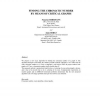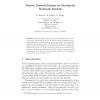1542 search results - page 57 / 309 » The metamathematics of random graphs |
INFOCOM
2003
IEEE
15 years 3 months ago
2003
IEEE
— Considerable attention has been focused on the properties of graphs derived from Internet measurements. Router-level topologies collected via traceroute-like methods have led s...
TOMS
2010
14 years 8 months ago
2010
The Tutte polynomial of a graph, also known as the partition function of the q-state Potts model, is a 2-variable polynomial graph invariant of considerable importance in both comb...
125
click to vote
ENDM
2000
14 years 9 months ago
2000
We propose a new exact algorithm for finding the chromatic number of a graph G. The algorithm attempts to determine the smallest possible induced subgraph G' of G which has t...
CAAN
2007
Springer
15 years 4 months ago
2007
Springer
Abstract. Random graphs with given expected degrees G(w) were introduced by Chung and Lu so as to extend the theory of classical G(n, p) random graphs to include random power law g...
122
click to vote
CSR
2011
Springer
14 years 1 months ago
2011
Springer
The Goldreich’s function has n binary inputs and n binary outputs. Every output depends on d inputs and is computed from them by the fixed predicate of arity d. Every Goldreich�...


